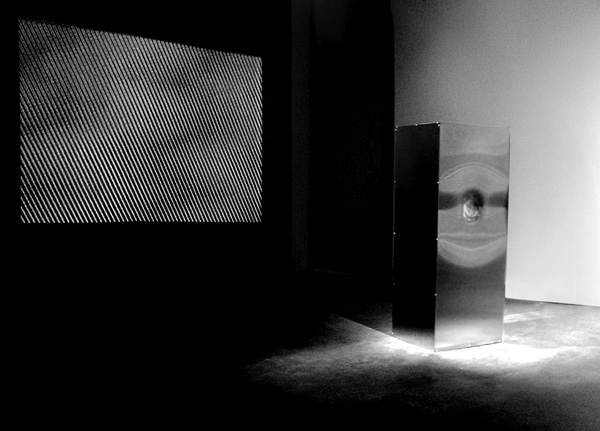
HEADBANGER
first performed on September 25, 2015
Miller Gallery, Carnegie Mellon University, Pittsburgh, PA
performed twice in 2015
VICTORIA KEDDIE
Brooklyn, NY
victoriakeddie.com
HEADBANGER
VICTORIA KEDDIE
The performative installation involves a visual score, a visualized sound recording, a fabricated stainless steel sculpture, and a live performance.
For the visual score/sound based composition, I focused on the subtype of sleep related rhythmic movement disorder (RMD), “Headbanging.” This RMD typically involves repetitive lifting of the head along with forcibly banging the head on a pillow or mattress; or slamming the back of the head against a headboard or wall. Through EMG analysis, this sleep movement behavior is shown to occur in rhythmic, percussive intervals.
As an artist who works extensively in signal generation and signal-to-signal response, EMG testing allows for the opportunity to investigate the human variable as both generator and conductor of signal. During the unconscious state, the body performs violently onto itself thus generating rhythmic noise, and in turn the EMG signals communicate these sounds as electronic signatures. My performance involves the translation of these violent actions in the unconscious, registered as electromagnetic signals, with a composition for sound using the very elements of signal to signal response, human movement, and quasi-rhythmic sequencing.
The graphic score consists of test results involving three anonymous patients that were released in the Journal of Clinical Sleep Medicine, Volume 08 No 04. The patients—two males and one female—were afflicted with atypical headbanging. All three cases had RMD with atypical headbanging, or head slapping, consisting of head punching and head slapping where the head bangs itself rhythmically, frontwards and/or backwards and/or the head is banged rhythmically/quasi-rhythmically.
The fabricated steel sculpture recreates the dynamic of the machine in the space. The stainless steel box fits the exact dimensions of the polygraph unit used to conduct these documented EMG readings. The center of the sculpture has been dented severely to link the human presence in relation to the machine. The dent is dome-shaped in appearance and remarks on the repeated banging against a solid structure. The steel box is activated in a live performance in the space when, as part of the sound-based performance, certain frequencies cause the sculpture to resonate, creating a vibration heavy environment momentarily throughout the piece. The sculpture, like the room, resonates with an active—yet invisible—energy, much like one’s unconscious state.
The performance is approximately 30 minutes in length and is performed in three parts in correlation to the three patients’ EMG readings.